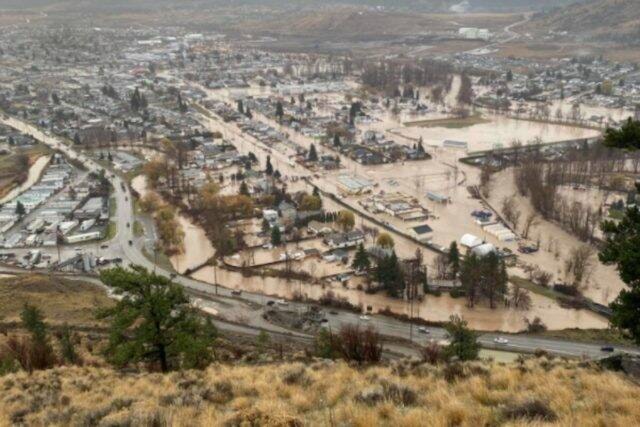Insurance experts and municipal leaders are welcoming B.C.’s new flood strategy, but they also find room for improvement.
Aaron Sutherland, Insurance Bureau of Canada’s Western and Pacific vice-president, welcomed the flood strategy announced March 21 by Emergency Management Minister Bowinn Ma and Water, Land and Resource Stewardship Minister Nathan Cullen.
“We are still supportive of the direction that the (province) is trying to move,” Sutherland said. “I think we have to be candid with ourselves. We don’t have a good understanding of flood risk here in B.C. or in this country in many areas.”
The flood strategy promises to “first and foremost” improve mapping, Sutherland added. But this also means that right now it is difficult to pinpoint where investments are necessary.
“In different areas, we have different understandings of the flood risk we face, ” he said. “Why has it been so difficult? It’s because it can fall on different levels of government. Different levels of government have different abilities to resource (mapping).”
A lot of smaller, rural municipalities, where the flood risk might be the greatest, might not have the resources to even start a flood mapping project, he said, adding that the provincial government continues to provide resources.
“In some areas, we have flood maps but they are just woefully out-of-date,” Sutherland said.
Another factor concerns the flooding models themselves. What might have been appropriate in the past, might be no longer because of the changing climate. A 1-in-50-years-flood might turn into a 1-in-20-years flood, he said.
While Sutherland said the strategy is not “perfect,” it is “a pretty good starting point” to get a handle on the geography of risk.
“Once we have that understanding, that’s where we can then layer in prioritized investments and risk mitigation.”
Experts expect flooding to increase with climate change and B.C. has the third-highest risk, according to the Insurance Bureau of Canada.
A federal government report released in August 2022 found B.C. is home to almost 280,000 residential properties — 14 per cent of all residential properties — within the second-highest risk category as measured by average annual loss expected from flooding. Another 48,000 B.C. properties — tops for Canada — were in the highest risk category.
Experts have pegged the annual cost of proofing communities against flooding in the billions. The provincial government coupled the release of its flood strategy with announcing $39 million for 50 different projects across B.C. to help communities prepare, including money for flood mapping.
RELATED: 2021 atmospheric rivers cost $675M in insurance losses, were Canada’s 8th worst natural disaster
Merritt Mayor Michael Goetz said the new flood strategy will help some communities “sleep better at night” because it is addressing some weak points.
“But we need a diking strategy, so I’m hoping government addresses that,” he said.
Merritt, along with nearby Princeton and more distant Abbotsford in the Fraser Valley, experienced catastrophic flooding in the fall of 2021 following a series of atmospheric rivers. In the case of Merritt, the Coldwater River caused damages of around $150 million after it had breached local dikes, forcing the evacuation of 7,000 residents.
Efforts to rebuild key municipal infrastructure continue, but 21 families are still out of their home, according to Goetz.
“(That’s) unacceptable,” he said. “That should not be happening.”
A central missing piece in Merritt’s recovery and future flood mitigation is the replacement of two dikes.
The first is protecting Merritt’s public works yard, including the municipality’s water and waste water treatment plant, located at the confluence of the Nicola and the Coldwater Rivers. The facility failed during the flood, but escaped damage otherwise. Construction is scheduled to start in June 2024 with $2 million coming from the province, but with more money needed. The other dike is near an RV park with the province having chipped $2 million.
Merritt is also planning to improve other dikes with an estimated price tag of $109 million as of November 2022 — a figure “beyond the internal funding” ability of Merritt.
“Funding is key,” Goetz said, who last May complained to federal legislators about the pace of federal support, but also jurisdictional disputes between provincial and federal authorities.
“We are now going into the start of Year Three and we’re still talking about funding,” he said. “So yes, I’m concerned that funding hasn’t been addressed…and we are still trying to debate, who is going to pay for what.”
Goetz called on federal and provincial officials to simplify the process.
“Either the federal government runs this thing from start to finish or the provincial (government), but make a decision,” he said. “(Do) something to make this work better because climate change is changing the way we live and you have to be able to respond to it as quickly as possible.”
Goetz rates the chance of flooding at “zero” because of this year’s low snow-pack, but every community with two rivers running through will experience some flooding.
“So yeah, there’s a real possibility and that is why we were fighting as hard as we are for the dikes,” he said.
Speaking at the reveal of the flood strategy, Cullen said government finds itself in a “very good dialogue” with Merritt.
Overall, Cullen said the flood strategy will help assess flood risks with floodplain mapping, increase communication with local and First Nation governments, better prepare for floods and response and help with flood resilience.
“We know there is more to do,” he said.
Grand Forks Mayor Everett Baker said his municipality is excited to see how the flood strategy will build on the lessons from the last seven years of flooding disasters in B.C. and beyond.
“Climate change is bringing increasingly extreme events to our region, far outside the expected probability and severity. We look forward to deepening our understanding and ability to address flood risk through this new flood strategy,” Baker said.
